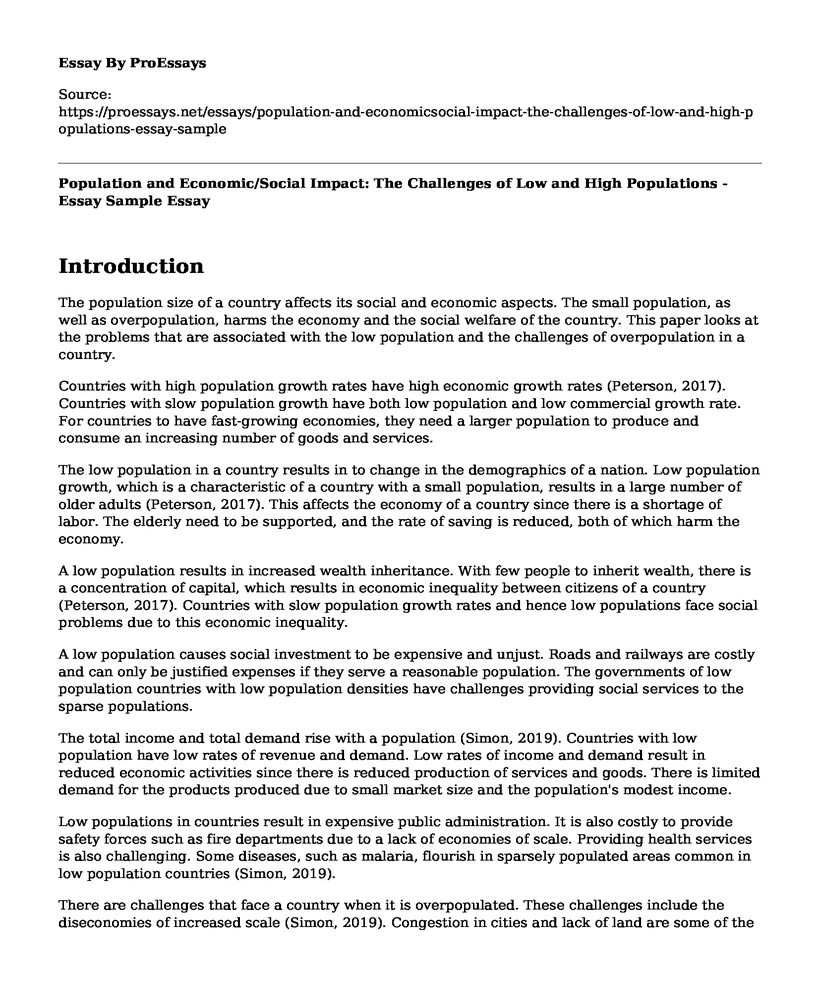Introduction
The population size of a country affects its social and economic aspects. The small population, as well as overpopulation, harms the economy and the social welfare of the country. This paper looks at the problems that are associated with the low population and the challenges of overpopulation in a country.
Countries with high population growth rates have high economic growth rates (Peterson, 2017). Countries with slow population growth have both low population and low commercial growth rate. For countries to have fast-growing economies, they need a larger population to produce and consume an increasing number of goods and services.
The low population in a country results in to change in the demographics of a nation. Low population growth, which is a characteristic of a country with a small population, results in a large number of older adults (Peterson, 2017). This affects the economy of a country since there is a shortage of labor. The elderly need to be supported, and the rate of saving is reduced, both of which harm the economy.
A low population results in increased wealth inheritance. With few people to inherit wealth, there is a concentration of capital, which results in economic inequality between citizens of a country (Peterson, 2017). Countries with slow population growth rates and hence low populations face social problems due to this economic inequality.
A low population causes social investment to be expensive and unjust. Roads and railways are costly and can only be justified expenses if they serve a reasonable population. The governments of low population countries with low population densities have challenges providing social services to the sparse populations.
The total income and total demand rise with a population (Simon, 2019). Countries with low population have low rates of revenue and demand. Low rates of income and demand result in reduced economic activities since there is reduced production of services and goods. There is limited demand for the products produced due to small market size and the population's modest income.
Low populations in countries result in expensive public administration. It is also costly to provide safety forces such as fire departments due to a lack of economies of scale. Providing health services is also challenging. Some diseases, such as malaria, flourish in sparsely populated areas common in low population countries (Simon, 2019).
There are challenges that face a country when it is overpopulated. These challenges include the diseconomies of increased scale (Simon, 2019). Congestion in cities and lack of land are some of the diseconomies of scale. Countries with large populations have large cities that are congested due to lack of space. These countries have challenges in providing proper housing for these populations.
Social services such as health facilities and roads are congested and fail to deliver the services effectively. Health services are limited, and the spread of contagious diseases is likely when there is a high population density.
Natural resources are depleted due to the increased demand for food and other goods and services(Eyo & Ogo, 2013). The natural resources are used in an unsustainable manner, fulfilling the needs of the large population.
Air pollution is increased when there is an overpopulation (Eyo, & Ogo, 2013). Increased demand by the population results in increased demand for energy and cannot be easily met without the use of fossil fuels, which leads to air pollution.
Overpopulation results in poverty. Children born in poor homesteads face possible malnutrition and starvation(Eyo, & Ogo, 2013). There is a challenge in providing clean water and food to these children.
Conclusion
The population of a country affects its economy as seen there many challenges that face countries with low populations such as the increased cost of public administration and the provision of social services. Overpopulated countries face challenges due to the strain of the available resources.
References
Eyo, E. O., & Ogo, U. I. (2013). The environmental implication of overpopulation and rural-urban migration on development in Nigeria. Academic Research International, 4(6), 261.
Peterson, E. W. F. (2017). The role of the population in economic growth. SAGE Open, 7(4), 2158244017736094.
Simon, J. L. (2019). The economics of population growth. Princeton university press.
Cite this page
Population and Economic/Social Impact: The Challenges of Low and High Populations - Essay Sample. (2023, Apr 01). Retrieved from https://proessays.net/essays/population-and-economicsocial-impact-the-challenges-of-low-and-high-populations-essay-sample
If you are the original author of this essay and no longer wish to have it published on the ProEssays website, please click below to request its removal:
- Research Paper on Psychological and Emotional Effects on Children of Different Parenting Styles
- Analysis of Economic Policies of HP Inc. Paper Example
- Expatriate Employees: Rewarding for Successful Overseas Branches - Essay Sample
- California Restaurant Owner Opposes Rising Minimum Wage - Essay Sample
- 4 Universal Compensable Factors: Skill, Effort, Responsibility, & Work Conditions - Essay Sample
- Essay Example on Globalization Brings Cumulative Crisis in African Nations: A Study
- Effective Communication: The Key to Great Relationships - Free Essay Example







